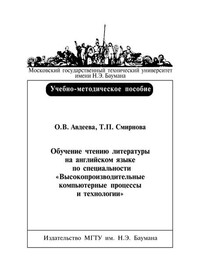Обучение чтению литературы на английском языке по специальности «Высокопроизводительные компьютерные процессы и технологии»
Покупка
Тематика:
Английский язык
Год издания: 2007
Кол-во страниц: 40
Дополнительно
Вид издания:
Учебно-методическая литература
Уровень образования:
ВО - Бакалавриат
Артикул: 840505.01.99
Пособие содержит оригинальные тексты на английском языке об основных этапах развития и принципах работы суперкомпьютеров и сетей определенного типа, а также о новейших исследованиях применения суперкомпьютеров в современных технологических процессах. Кроме того, в пособие включены задания и упражнения, позволяющие овладеть терминологией и языковыми оборотами, необходимыми для понимания и перевода научно-технической литературы. Для студентов 3-го курса факультета «Информатика и системы управления».
Скопировать запись
Фрагмент текстового слоя документа размещен для индексирующих роботов
Московский государственный технический университет имени Н.Э. Баумана О.В. Авдеева, Т.П. Смирнова Обучение чтению литературы на английском языке по специальности «Высокопроизводительные компьютерные процессы и технологии» Учебно-методическое пособие Москва Издательство МГТУ им. Н.Э. Баумана 2007
УДК 802.0
ББК 81.2 Англ-923
А18
Рецензенты: Ю.М. Козлов, Н.В. Пальченко
Авдеева О.В., Т.П. Смирнова
Обучение чтению литературы на английском языке по специальности «Высокопроизводительные компьютерные процессы
и технологии»: Учеб.-метод. пособие. – М.: Изд-во МГТУ
им. Н.Э. Баумана, 2007. – 40 с.
Пособие содержит оригинальные тексты на английском языке об основных этапах развития и принципах работы суперкомпьютеров и сетей
определенного типа, а также о новейших исследованиях применения суперкомпьютеров в современных технологических процессах. Кроме того,
в пособие включены задания и упражнения, позволяющие овладеть терминологией и языковыми оборотами, необходимыми для понимания и
перевода научно-технической литературы.
Для студентов 3-го курса факультета «Информатика и системы
управления».
УДК 802.0
ББК 81.2 Англ-923
©
МГТУ им. Н.Э. Баумана, 2007
А18
ПРЕДИСЛОВИЕ Пособие содержит основные и дополнительные тексты по специальности, задания и упражнения, позволяющие усвоить и закрепить необходимый лексический материал, отработать перевод грамматических конструкций. В оригинальных текстах из американской технической литературы отражены новейшие тенденции высокопроизводительных компьютерных процессов и технологий. Осуществляя лексикограмматический анализ этих текстов, студенты приобретают навыки понимания и перевода научно-технической литературы соответствующего профиля. В конце каждого из шести разделов пособия помещены словари с основной лексикой. Пособие предназначено для студентов факультета «Информатика и системы управления», обучающихся по специальности «Высокопроизводительные компьютерные процессы и технологии».
UNIT 1 TASK 1. Read, translate and retell the text. Text 1A. The Next Generation What is required for the next generation of computers is not simply jamming an ever-larger number of ever-smaller components onto a piece of silicon – that line of effort is costing more and yielding proportionately less speed. What’s required is a complete rethinking of the way computers are built and the way they process information. From von Neumann’s first computer to the world’s fastest single processor, the Cray 1 supercomputer, computers have always done tasks essentially one at a time. The central processing unit, or CPU, fetches a pair of numbers from memory, adds them and replaces them in memory. Processing speed is limited not by the speed of the CPU but by the narrow pathway between the CPU and memory. Shuttling operands and results back and forth is like trying to condense all the traffic on a freeway at rush hour down to one lane. Computer scientists call the resulting traffic jam “the von Neumann bottleneck”. Researchers working to build the next generation of computers are counting on parallelism (using many processors, each of which works on a piece of a larger problem) to detour around the von Neumann bottleneck and achieve revolutionary increases in speed. Progress in developing serial computers, and the difficulty of coordinating more than one CPU, forced parallelism to the background. The first truly parallel computers emerged in the 1970s. Two trends spurred the research forward: a need for more processing power and the revival of artificial intelligence research. By copying some of the brain’s processing strategies, researchers hope to build computers capable not only of solving large scientific problems but also of reproducing human intellect. Computer evolution having main milestones, it is often broken up into generations. First Generation. From the first computer to the IBM 650, 1947 to 1956, computers relied on vacuum tubes as their basic switching element, and for memory, they used magnetic drums and cathode ray tubes.


